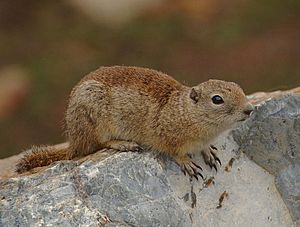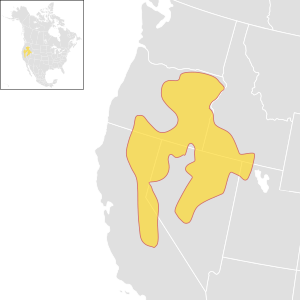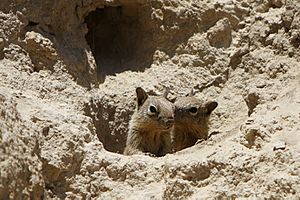Belding's ground squirrel facts for kids
Quick facts for kids Belding's ground squirrel |
|
|---|---|
 |
|
| Conservation status | |
| Scientific classification | |
| Genus: |
Urocitellus
|
| Species: |
beldingi
|
 |
|
| Distribution of the Belding's ground squirrel | |
| Synonyms | |
|
Spermophilus beldingi Merriam, 1888 |
|
The Belding's ground squirrel (Urocitellus beldingi) is a small, busy animal. People also call it pot gut, sage rat, or picket-pin. This squirrel lives in the mountains of the western United States. In California, you can often find them in meadows. They live at high elevations, from about 6,500 feet (2,000 m) to 11,800 feet (3,600 m). Their home stretches from Lake Tahoe all the way to Kings Canyon. Good news! This squirrel species is not in danger. Many of the places they live are protected areas.
Contents
What Does a Belding's Ground Squirrel Look Like?
The Belding's ground squirrel is a medium-sized squirrel. It has a short tail, short legs, and small ears. Its fur is mostly gray. But it turns a bit cinnamon (light brown) on its belly. The back of the squirrel is a reddish-brown color.
These squirrels are about 230 millimetres (9.1 in) to 300 millimetres (12 in) long. Their tail is bushy but flat, measuring 44 millimetres (1.7 in) to 76 millimetres (3.0 in). The hairs on the end of their tail have three colors: black, white, and red. On average, a Belding's ground squirrel weighs about 290 grams (0.64 lb). Their feet have very little hair. They also have cheek pouches that are a medium size. They use these pouches to carry food.
Where Do Belding's Ground Squirrels Live and What Do They Eat?
Where Do They Live?
Belding's ground squirrels are native to the northwestern United States. Their home includes parts of Oregon, Washington, northern California, Idaho, Nevada, and Utah. They love living in high places like mountain meadows. You can also find them in areas with sagebrush, grassy spots, and even farms.
These squirrels mostly stick to open areas. They need fresh plants and water. They avoid thick forests, tall grasses, rocky slopes, or dense bushes. Why? Because they need to see predators coming! But they also don't like grass that's too short, as they need some cover to hide.
What Do They Eat?
Belding's ground squirrels mostly eat plants. This means they are largely herbivores. But they are not super picky! They will also eat insects, dead animals, other small animals, and even other squirrels sometimes. Their favorite foods are flowers and seeds. They also enjoy nuts, grains, roots, bulbs, mushrooms, and green plants.
Unlike some animals, Belding's ground squirrels don't store food in hidden spots. Instead, they store fat in their bodies. This means they eat a lot before they go into hibernation. They might spend as much as 40% of their summer just eating! When they eat, they stand on their back legs and use their front paws to hold their food.
How Do They Hibernate?
Belding's ground squirrels hibernate, which means they go into a deep sleep for the winter. When they start hibernating depends on a few things. It depends on if they are male or female, how old they are, and how high up in the mountains they live.
Adult males usually go into hibernation first. This happens between late July and early September in higher areas. Females might follow them in late September. Young squirrels go into hibernation after their parents. Young females go when they are about 13 weeks old. Young males go when they are about 10 weeks old. They start hibernating when the grass begins to dry out. This helps them avoid the hot, dry end of summer.
These squirrels hibernate in special underground rooms called hibernacula. Males often hibernate alone. But females tend to hibernate together. When they wake up from hibernation also depends on different things. In lower areas, males come out in February. In higher areas, they emerge at the end of April. Females wake up over several weeks.
What Do They Do All Day?
Belding's ground squirrels leave their burrows when the sun comes up. The first squirrel to come out usually stays near the burrow entrance. It waits until enough other squirrels are above ground to help watch for predators. Then, the squirrels move farther away from their burrows.
Most of their activity happens in the morning. They spend time digging and eating. As the temperature gets hotter, the squirrels become less active. They often spend much of the day stretched out on rocks or on the ground. They do this to soak up warmth from the sun. They also fix up their burrows and groom each other. When young squirrels are above ground, they love to play! In the afternoon, the ground squirrels go back into their burrows. Young squirrels tend to stay out later than adults.
How Do Belding's Ground Squirrels Behave?
Family Life
Belding's ground squirrels live in groups where family is very important. Most of their interactions happen between females and their children or other relatives. It seems that squirrels cooperate more with others who are closely related to them.
How do they know who's family? They recognize their relatives by scent! They have special glands that leave a strong smell in dusty areas where they roll around. Each squirrel has its own unique set of smells. If another squirrel's smell matches, it might be a relative. A female might even use her sister's scent to figure out if unfamiliar females are related.
Recognizing family is super important for female Belding's ground squirrels. It helps them know who to protect when defending their nests or territories. It also helps them decide who to warn with alarm calls. Related females will sometimes share food and shelter too. Adult males don't show this family-focused behavior. They tend to move around a lot between seasons. Even though many squirrels live in colonies, they don't interact much with each other. When they do, it's often a bit aggressive.
Alarm Calls
Belding's ground squirrels have many predators. These include coyotes, bobcats, weasels, eagles, and badgers. They also see humans, farm animals, and cars as threats. Ground squirrels have two main alarm calls to warn others about danger.
One call is called the churr call or trill. It's a series of more than five quick notes. They use this call for predators that are less of an immediate threat, usually predators on the ground. Squirrels close to the caller will respond by standing on their back legs (called "posting"). They might also run onto a rock to get a better view. Or they might run back to their safe area near the burrow.
The other alarm call is a whistle. This is a single, high-pitched sound. They use this call for immediate dangers, usually predators from the sky like eagles. All squirrels who hear this call will try to escape quickly. They might crouch down or run into the nearest shelter. When running from flying predators, squirrels will call while they are escaping. But when running from ground predators, they don't call until they are safe. Also, with flying predators, all squirrels will call. But with ground predators, only females with family nearby will call. The squirrel that first makes the alarm call will stand up, look at the predator, and won't try to hide.
Having Babies and Raising Them
Female Belding's ground squirrels have one group of babies each year. Pregnant females dig special nesting burrows. They gather grass and roots to make cozy nests. They set up territories around these burrows just for nesting. Females protect these burrows from other squirrels that are not related to them. They will attack and chase away intruders. They defend their territories until their young are old enough to be on their own.
A mother squirrel is pregnant for about 23 to 31 days. Babies are born in late June to early July in higher mountain areas. In lower areas, like Central Oregon, babies are born in March. They all come out of their dens around mid-April when the first warm spring days arrive. A mother can have anywhere from 3 to 8 babies at a time. Only the mother takes care of the young. Males leave right after mating.
For their first few weeks, the babies stay underground in the nesting burrow. They first come out of the burrows in July and early August (in higher areas). They stop drinking milk from their mother when they are about 27 days old. At first, the young stay close to the burrow entrance. But they start exploring on their third day above ground. Male squirrels leave their birth burrow after they are weaned. They keep moving to new places after they successfully mate. The male who mates the most moves farthest away from the group he mated with. Females rarely move away from their birth burrows.
Belding's Ground Squirrel Family Tree
The Belding's ground squirrel was first described by a scientist named Clinton Hart Merriam in 1888. He called it Spermophilus beldingi back then. Today, we generally recognize three different types (subspecies) of Belding's ground squirrel:
- U. b. beldingi (Merriam, 1888)
- U. b. creber Hall, 1940
- U. b. oregonus (Merriam, 1898)



